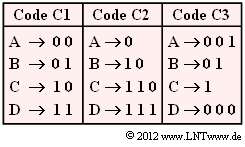Exercise 2.2Z: Average Code Word Length
The aim of data compression is to represent the message of a source with as few binary characters as possible.
We consider here a discrete message source with the symbol set $\rm \{ A, \ B, \ C, \ D\}$ ⇒ symbol set size $M = 4$ and the symbol probabilities
- $p_{\rm A} = p_{\rm B} = p_{\rm C} = p_{\rm D} = 1/4$ $($subtask $1)$,
- $p_{\rm A} = 1/2, \, p_{\rm B} = 1/4, \, p_{\rm C} = p_{\rm D} = 1/8$ $($subtask $2$ to $5)$.
It is assumed that there are no statistical Dependencies between the individual source symbols.
Three assignments are given. To be noted:
- Each of these binary codes $\rm C1$, $\rm C2$ and $\rm C3$ is designed for a specific source statistic.
- All codes are prefix-free and thus immediately decodable without further specification.
A measure for the quality of a compression method is the average code word length $L_{\rm M}$ with the additional unit "bit/source symbol".
Hint:
- The exercise belongs to the chapter General Description of Source Coding.
Questions
Solution
- $$L_{\rm M} = p_{\rm A} \cdot L_{\rm A} + p_{\rm B} \cdot L_{\rm B}+ p_{\rm C} \cdot L_{\rm C} + p_{\rm D} \cdot L_{\rm D} \hspace{0.05cm}.$$
If the four source symbols are equally probable $($all probabilities exactly $1/4)$, then for this we can also write:
- $$L_{\rm M} = 1/4 \cdot ( L_{\rm A} + L_{\rm B}+ L_{\rm C} + L_{\rm D}) \hspace{0.05cm}.$$
- $\text{Code C1:}$ $L_{\rm M} \hspace{0.15cm}\underline{= 2.00}\ \rm bit/source\hspace{0.15cm} symbol$,
- $\text{Code C2:}$ $L_{\rm M} \hspace{0.15cm}\underline{= 2.25}\ \rm bit/source\hspace{0.15cm} symbol$
- $\text{Code C3:}$ $L_{\rm M} \hspace{0.15cm}\underline{= 2.25}\ \rm bit/source\hspace{0.15cm} symbol$.
(2) With the code table $\text{C1}$ , the average code word length $L_{\rm M} \hspace{0.15cm}\underline{= 2}\ \rm bit/source\hspace{0.15cm} symbol$ is always obtained, independent of the symbol probabilities.
For the other two codes one obtains:
- $\text{Code C2:}$ $L_{\rm M} = 1/2 \cdot 1 + 1/4 \cdot 2 + 1/8 \cdot 3 + 1/8 \cdot 3 \hspace{0.15cm}\underline{= 1.75}\ \rm bit/source\hspace{0.15cm} symbol$,
- $\text{Code C3:}$ $L_{\rm M} = 1/2 \cdot 3 + 1/4 \cdot 2 + 1/8 \cdot 1 + 1/8 \cdot 3 \hspace{0.15cm}\underline{= 2.50}\ \rm bit/source\hspace{0.15cm} symbol$.
From the example you can see the principle:
- Probable symbols are represented by a few binary symbols, improbable ones by more.
- In the case of equally probable symbols, it is best to choose the same code word lengths.
(3) Solution suggestion 1 is correct:
- The code $\text{C1}$ with uniform length of all code words is prefix-free,
- but other codes can also be prefix-free, for example the codes $\text{C2}$ and $\text{C3}$.
(4) Solution suggestion 1 is correct:
- Already from "00" at the beginning one can see that the code $\text{C2}$ is out of the question here,
because otherwise the source symbol sequence would have to begin with "AA". - In fact, the code $\text{C1}$ was used.
(5) Solution suggestion 2 is correct.
The first suggested solution gives the source symbol sequence for code $\text{C2}$ if the encoded sequence would be "$\rm 001101111001100100111000$".
